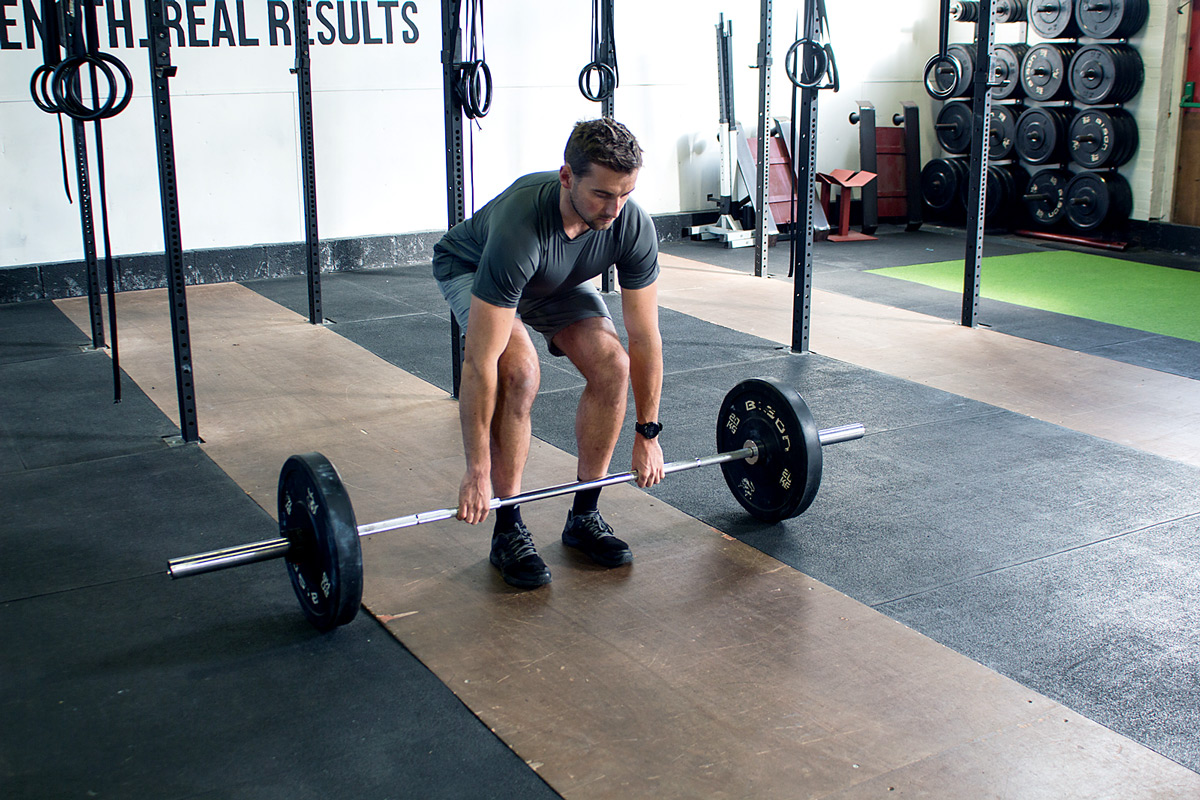Home>Misc>Featured>How To Combine Long Distance Running And Weight Lifting


Featured
How To Combine Long Distance Running And Weight Lifting
Modified: January 22, 2024
Discover how you can excel in both long distance running and weight lifting with our featured guide. Enhance your endurance and strength simultaneously for optimal fitness results.
Introduction
Welcome to the world of fitness where the possibilities are endless! Have you ever considered combining long distance running and weight lifting to take your workouts to the next level? If you’re looking to boost your overall fitness, improve your running performance, and build strength, this article is for you.
Long distance running and weight lifting are two distinct forms of exercise, each with their own set of benefits. Long distance running is a cardiovascular activity that improves endurance, burns calories, and promotes overall cardiovascular health. On the other hand, weight lifting focuses on building muscle strength and power, enhancing bone density, and improving body composition.
Now, you might be wondering: why combine these two seemingly different forms of exercise? Well, the answer lies in the synergistic effects they can have on your fitness journey. When properly integrated, long distance running and weight lifting can help you achieve a well-rounded fitness routine that encompasses both cardiovascular health and muscular strength.
In this article, we will explore the benefits of combining long distance running and weight lifting, considerations before integrating the two, and how to create a balanced training schedule that maximizes your results. We’ll also delve into warm-up and cool-down routines, nutrition and hydration tips, recommended exercises for runners, and weight lifting exercises specifically designed to complement your running routine. Additionally, we’ll discuss the importance of rest and recovery, as well as how to monitor your progress and make necessary adjustments to your training plan.
By the end of this article, you’ll have a comprehensive understanding of how to combine long distance running and weight lifting effectively, setting yourself up for success on your fitness journey. So, let’s dive in and discover how these two powerful forms of exercise can synergize for incredible results.
Benefits of combining long distance running and weight lifting
When it comes to fitness, variety is the spice of life. Combining long distance running and weight lifting can offer a range of benefits that go beyond what each form of exercise can achieve on its own. Let’s explore some of the advantages of integrating these two activities into your fitness routine.
Improved overall fitness: Long distance running helps to enhance cardiovascular endurance, while weight lifting strengthens muscles, bones, and joints. By combining the two, you can improve your overall fitness by targeting different aspects of your physical health.
Enhanced running performance: Weight lifting can improve running performance by increasing leg strength, power, and stability. Stronger leg muscles can propel you forward more efficiently, leading to improved speed and endurance.
Reduced risk of injury: Weight lifting helps to strengthen muscles and connective tissues, which can provide better support and stability for runners. This reduces the risk of common running injuries such as sprains, strains, and stress fractures.
Increased calorie burn: Combining long distance running and weight lifting creates a powerful calorie-burning effect. While running helps burn calories during your workout, weight lifting continues to burn calories even after your session, thanks to the increase in muscle mass and metabolism.
Better body composition: Weight lifting helps to increase muscle mass and decrease body fat percentage. Combining it with long distance running can help you achieve a leaner, more toned physique.
Improved bone density: Long distance running is considered a weight-bearing activity that helps improve bone density. Adding weight lifting to your routine further strengthens bones, reducing the risk of osteoporosis and fractures.
Mental benefits: Engaging in both long distance running and weight lifting has positive effects on mental health. These activities release endorphins, reduce stress, boost mood, and enhance overall well-being.
Versatility in training: By combining long distance running and weight lifting, you create a versatile training routine that targets multiple aspects of fitness. This variety can help prevent boredom and keep you motivated to consistently work towards your fitness goals.
These are just a few of the benefits you can experience from integrating long distance running and weight lifting into your fitness routine. Now that you understand the advantages, let’s explore some important considerations before you start combining these two activities.
Considerations before combining long distance running and weight lifting
While combining long distance running and weight lifting can be highly beneficial, it’s essential to consider a few factors before diving into this hybrid training approach. Taking these considerations into account will help you design a safe and effective workout regimen. Let’s explore them.
Individual fitness level: Assess your current fitness level before embarking on a combined training program. If you’re new to either activity, it’s important to gradually introduce both running and weight lifting into your routine. This will help prevent overexertion or injury.
Time commitment: Combining two forms of exercise requires adequate time for recovery, especially if you plan to engage in intense workouts. Make sure you have enough time to dedicate to both running and weight lifting to avoid overtraining and burnout.
Training goals: Consider your fitness goals and how combining running and weight lifting aligns with them. Are you looking to improve endurance, build muscle, or both? Understanding your goals will help you prioritize and tailor your training program accordingly.
Proper form and technique: Both running and weight lifting require proper form and technique to minimize the risk of injury. If you’re new to weight lifting, it’s advisable to work with a qualified trainer who can guide you in performing exercises with correct form. Additionally, focus on maintaining proper running form to prevent strains and other running-related injuries.
Recovery and rest: Adequate rest and recovery are crucial when combining long distance running and weight lifting. Incorporate rest days into your training schedule to allow your body to repair and adapt to the physical demands placed on it. Overtraining can lead to decreased performance and an increased risk of injury.
Gradual progression: Gradually increase the intensity and volume of your workouts to avoid pushing your body beyond its limits. This gradual progression allows your body to adapt and reduce the risk of overuse injuries. Listen to your body and adjust your training as needed.
Flexible training schedule: Long distance running and weight lifting can be demanding on the body. It’s important to have a flexible training schedule that allows you to adjust your workouts based on how your body feels. Pay attention to any signs of fatigue, pain, or discomfort. If needed, modify your training plan accordingly.
Consultation with healthcare professionals: If you have any pre-existing health conditions or concerns, it’s always wise to consult with healthcare professionals before starting a new exercise routine. They can provide guidance specific to your individual needs and help ensure your safety and well-being.
By considering these factors before combining long distance running and weight lifting, you can set yourself up for a successful and injury-free training experience. Next, we’ll delve into how to create a balanced training schedule that incorporates both activities effectively.
Creating a balanced training schedule
When combining long distance running and weight lifting, it’s crucial to create a balanced training schedule that allows for optimal performance and recovery. A well-structured schedule will help you maximize the benefits of both activities while avoiding overexertion and minimizing the risk of injury. Here are some tips to help you create a balanced training schedule:
Set specific goals: Define your goals for both running and weight lifting. Whether you aim to improve your running speed, increase your endurance, or build muscle strength, having specific goals will guide your training and help you determine the appropriate frequency and intensity of workouts.
Determine training days: Allocate specific days for running and weight lifting workouts. Consider your availability and recovery needs. Aim for a combination of both activities throughout the week, allowing for rest days in between to promote recovery.
Alternate training activities: Rather than performing both activities on the same day, it’s recommended to alternate between running and weight lifting sessions. This allows your body to focus on each activity individually, reducing the risk of fatigue and overuse injuries.
Vary intensity and duration: Gradually increase the intensity and duration of your runs and weight lifting workouts over time. Incorporate low-intensity, long-distance runs, as well as high-intensity interval training (HIIT) sessions. Similarly, vary the intensity and rep ranges of your weight lifting workouts to target different muscle groups and promote overall strength development.
Include rest days: Make sure to schedule rest days for recovery. These days are essential for muscle repair and adaptation. Use this time to engage in light stretching, foam rolling, or other low-impact activities to promote blood flow and aid in recovery.
Consider cross-training: Include cross-training activities that complement running and weight lifting. Activities such as swimming, cycling, yoga, or Pilates can help improve flexibility, balance, and overall muscle strength without placing excessive stress on the joints.
Listen to your body: Pay attention to your body’s signals and adjust your training schedule accordingly. If you’re feeling fatigued or experiencing pain, it’s important to take rest or recovery days. Pushing through fatigue or pain can lead to overtraining and potential injuries.
Gradually progress: Gradually increase the volume and intensity of your workouts over time. Avoid sudden spikes in mileage or lifting weight, as this can increase the risk of injuries. Stick to the principle of progressive overload by slowly and systematically pushing your limits while allowing the body to adapt.
Track and monitor progress: Keep a training log to track your runs, weight lifting sessions, and progress. Monitoring your performance can help you identify trends, evaluate your training methods, and make necessary adjustments to optimize your training schedule for continued progress.
By creating a balanced training schedule that incorporates both long distance running and weight lifting, you’ll be able to enjoy the benefits of both activities while minimizing the risk of overtraining and injury. Next, let’s explore the importance of warming up and cooling down in your combined training routine.
Warm-up and cool-down routines
Proper warm-up and cool-down routines are essential when combining long distance running and weight lifting. These routines help prepare your body for exercise, enhance performance, and aid in recovery. Let’s take a closer look at why warm-up and cool-down routines are important and how to incorporate them into your training:
Warm-up: Before starting any workout, it’s crucial to warm up your muscles and increase blood circulation. A dynamic warm-up routine can include exercises such as jogging in place, high knees, leg swings, arm circles, and squats. This helps raise your heart rate, lubricate the joints, and activate the muscles you’ll be using during your main workout.
A proper warm-up session should last around 10-15 minutes and gradually increase in intensity. Start with low-intensity movements and gradually progress to higher-intensity exercises. Focus on movements that engage the major muscle groups involved in your running and weight lifting exercises.
Cool-down: Cooling down after a workout is just as important as warming up. It allows your body to gradually return to its resting state and aids in recovery. Cooling down helps prevent blood pooling in the extremities and reduces the risk of dizziness or fainting.
After your main workout, incorporate a cool-down routine that consists of low-intensity exercises and stretching. This can include walking or light jogging, followed by static stretches that target the muscles you’ve worked during your session. Hold each stretch for about 20-30 seconds, being mindful of your breathing and ensuring a comfortable stretch without pain.
Cooldown stretches can focus on the hips, quads, hamstrings, calves, glutes, and upper body muscles. This helps lengthen tight muscles, improve flexibility, and aid in the recovery process.
Benefits of warm-up and cool-down routines:
- Improved circulation and blood flow to the muscles
- Enhanced muscle flexibility and range of motion
- Increased muscle and joint lubrication
- Activation of the nervous system and firing of muscle fibers
- Prevention of muscle strains or tears
- Reduced muscle soreness and stiffness post-workout
- Improved recovery and injury prevention
By incorporating warm-up and cool-down routines into your combined training schedule, you can optimize your performance, reduce the risk of injury, and promote a more efficient recovery process. Next, let’s explore some important nutrition and hydration tips to support your running and weight lifting endeavors.
Nutrition and hydration tips
Proper nutrition and hydration play a significant role in supporting your combined long distance running and weight lifting training. Fueling your body adequately before, during, and after workouts ensures optimal performance, recovery, and overall well-being. Here are some essential nutrition and hydration tips to keep in mind:
Pre-workout nutrition:
- Consume a balanced meal or snack 1-2 hours before your workout to provide your body with a steady source of energy. Include carbohydrates for fuel, lean proteins for muscle repair, and healthy fats for sustained energy.
- Avoid heavy meals immediately before exercising, as they can cause discomfort or sluggishness. Instead, opt for easily digestible foods such as fruits, oatmeal, whole grain toast, or yogurt.
- Stay hydrated by drinking water leading up to your workout to ensure proper hydration levels.
During exercise hydration:
- Sip on water throughout your workout to stay hydrated. The general rule of thumb is to drink about 4-6 ounces of water every 15-20 minutes during exercise.
- If you’re engaging in intense or prolonged exercise, consider incorporating a sports drink or electrolyte-enhanced water to replenish electrolytes lost through sweat.
Post-workout nutrition:
- Within 30 minutes of completing your workout, consume a combination of carbohydrates and protein to aid in muscle recovery. This can be in the form of a protein shake, a meal, or a snack that includes sources of both macronutrients.
- Include antioxidant-rich foods such as fruits and vegetables to combat oxidative stress caused by exercise.
- Hydrate properly by drinking water to replace fluid lost during exercise.
Overall nutrition tips:
- Follow a well-balanced diet that includes a variety of whole foods, including lean proteins, complex carbohydrates, healthy fats, and plenty of fruits and vegetables.
- Pay attention to portion sizes and listen to your body’s hunger and fullness cues.
- Consider working with a registered dietitian or nutritionist to tailor your nutrition plan to your specific needs and goals.
- Avoid skipping meals or restricting calories excessively, as this can negatively impact your energy levels and performance.
Remember, proper nutrition and hydration are key not only for performance but also for overall health and well-being. By fueling your body with the right nutrients and staying hydrated, you support your long distance running and weight lifting endeavors and promote optimal physical and mental functioning.
Now that we’ve covered nutrition and hydration, let’s explore specific exercises that can benefit your running routine as well as weight lifting exercises tailored for runners.
Recommended exercises for runners
As a runner, incorporating specific exercises into your training routine can help improve your form, enhance your performance, and reduce the risk of injuries. These exercises target key muscles used in running and can help you build strength, stability, and endurance. Here are some recommended exercises for runners:
1. Squats: Squats target the quadriceps, hamstrings, glutes, and calves. They help build lower body strength and power, improving your running efficiency and endurance. Start with bodyweight squats and gradually progress to weighted squats as your strength increases.
2. Lunges: Lunges work the quadriceps, hamstrings, glutes, and calves, as well as help improve balance and stability. Forward lunges, reverse lunges, and side lunges are all beneficial for runners. Perform them with or without weights depending on your fitness level.
3. Single-leg exercises: Single-leg exercises, such as single-leg squats, single-leg deadlifts, and step-ups, improve balance, stability, and coordination. They also help address any muscle imbalances and asymmetries that can lead to injuries.
4. Core exercises: A strong core is essential for maintaining proper running form and preventing injuries. Planks, Russian twists, bird dogs, and mountain climbers are effective exercises that target the core muscles. Include a variety of exercises that work both the front and back of your core.
5. Plyometric exercises: Plyometric exercises, like box jumps, jump squats, and bounding, help develop power and explosive strength. They simulate the quick, powerful movements needed during running, improving your speed and stride efficiency.
6. Hip exercises: Strong hip muscles, including the hips flexors, abductors, and external rotators, are crucial for maintaining proper hip alignment and stability. Clamshells, hip bridges, and lateral leg lifts are effective exercises for strengthening these muscles.
7. Calf raises: Strong calves are important for shock absorption and pushing off the ground during running. Perform standing calf raises or seated calf raises to strengthen the calf muscles and improve propulsion.
8. Cardiovascular cross-training: In addition to strength exercises, incorporate cardiovascular cross-training activities such as cycling, swimming, or using an elliptical machine. These activities provide low-impact alternatives that help build cardiovascular endurance without excessive stress on the joints.
9. Flexibility and mobility exercises: Include stretching and mobility exercises to improve flexibility and range of motion. Focus on stretching the quadriceps, hamstrings, calves, hip flexors, and glutes, as well as performing dynamic stretches and foam rolling to release tension in the muscles.
By incorporating these exercises into your training routine, you can enhance your running performance, reduce the risk of injuries, and improve overall strength and stability. However, it’s important to remember that every individual is unique, and it’s advisable to consult with a qualified fitness professional to tailor exercises to your specific needs and abilities.
Now, let’s explore weight lifting exercises specifically designed to complement your running routine.
Recommended weight lifting exercises for runners
Weight lifting exercises can greatly benefit runners by improving strength, power, and muscular endurance. Incorporating these exercises into your training routine can help enhance your running performance, reduce the risk of injuries, and promote overall body strength. Here are some recommended weight lifting exercises specifically designed for runners:
1. Deadlifts: Deadlifts are a compound exercise that targets multiple muscle groups, including the glutes, hamstrings, quadriceps, and lower back. They help build overall strength, improve posture, and increase power in the hip muscles – all of which are crucial for running.
2. Bulgarian split squats: This exercise is excellent for targeting the quadriceps, glutes, and hamstrings individually. It also helps improve balance and stability. Stand with one foot elevated behind you, perform a lunge movement, and repeat on the other side.
3. Step-ups: Step-ups target the quadriceps, hamstrings, and glutes. They help improve leg strength and stability, mimicking the movements used during uphill running. Use a step or bench that is around knee height and step up with one leg, then lower back down and repeat on the other side.
4. Hip thrusts: Hip thrusts primarily target the glutes and hamstrings. They help improve power in the hip muscles, which is essential for a strong stride in running. Perform hip thrusts by lying on your back with your feet flat on the ground, lifting your hips up, and squeezing your glutes at the top of the movement.
5. Single-leg Romanian deadlifts: This exercise is great for improving balance and strengthening the hamstrings and glutes. Stand on one leg, hinge forward at the hips while keeping your back straight, and lower your upper body towards the ground while lifting one leg behind you. Repeat on the other side.
6. Standing calf raises: Strong calf muscles are important for maintaining stability and power during running. Stand on the edge of a step or elevated surface with the balls of your feet, rise up onto your toes, and lower back down, targeting the calf muscles.
7. Lat pulldowns or pull-ups: These exercises target the back muscles and help improve upper body strength and posture. Strong back muscles contribute to maintaining proper running form and reducing fatigue during long runs.
8. Overhead press: The overhead press primarily targets the shoulder muscles and upper body strength. This exercise helps improve posture and supports the upper body’s stability, crucial for maintaining an efficient running stride.
9. Core exercises: In addition to weight lifting exercises, don’t forget to incorporate core exercises such as planks, Russian twists, and medicine ball exercises. A strong core provides stability, balance, and endurance while running.
When incorporating weight lifting exercises, focus on proper form and gradually increase weights and repetitions over time. It is crucial to listen to your body, perform exercises within your fitness level, and seek guidance from a qualified fitness professional if needed.
By including these weight lifting exercises into your training routine, you can improve your running performance, reduce the risk of injuries, and build overall strength. Remember to maintain a balanced training schedule, proper nutrition, and rest to support your running and weight lifting endeavors.
Now that we’ve covered the recommended exercises, let’s discuss the importance of incorporating rest and recovery days into your training plan.
Incorporating rest and recovery days
Rest and recovery days are an essential component of any training plan, including when combining long distance running and weight lifting. These days allow your body to repair, regenerate, and adapt to the physical stress placed upon it. Ignoring rest and recovery can lead to overtraining, plateaus in performance, and an increased risk of injuries. Here are some important considerations for incorporating rest and recovery days into your training plan:
1. Schedule regular rest days: Designate at least one or two days per week for complete rest or low-impact activities. This allows your muscles, joints, and nervous system to recover and adapt to the stress induced by running and weight lifting.
2. Listen to your body: Pay attention to your body’s signals and adjust your training accordingly. If you’re feeling excessively fatigued, experiencing persistent muscle soreness, or noticing a decline in performance, it may be a sign that you need more rest and recovery time. It’s important to prioritize rest when needed to avoid overtraining.
3. Active recovery: On rest days, consider incorporating light, low-impact activities such as walking, cycling, or yoga to promote blood flow, aid in muscle recovery, and maintain overall mobility. These activities can help loosen up tight muscles and provide mental relaxation.
4. Sleep and nutrition: Focus on getting adequate sleep and nourishing your body with proper nutrition. Sleep is crucial for muscle repair, hormone regulation, and overall recovery. Eating a balanced diet that includes an appropriate intake of macronutrients and micronutrients will support your recovery process.
5. Foam rolling and stretching: Include foam rolling and stretching exercises in your routine to help relieve muscle tension, reduce soreness, and improve flexibility. These activities can be done on rest days or as part of your warm-up and cool-down routines.
6. Cross-training: Incorporate cross-training activities, such as swimming, cycling, or Pilates, on rest days or as alternating workouts to give your body a break from impact activities. This can help maintain cardiovascular fitness, improve muscle balance, and provide a mental break from running and weight lifting.
7. Progression and recovery weeks: Incorporate progression weeks into your training plan, where you gradually increase the training load for a few weeks, followed by recovery weeks with reduced intensity or volume. This pattern allows your body to adapt to the stress of training and promotes ongoing progress without risking burnout or overtraining.
8. Recovery modalities: Explore additional recovery modalities such as massage therapy, compression garments, and ice baths to aid in muscle recovery and alleviate soreness. These modalities can help accelerate the recovery process and enhance overall performance.
Remember, rest and recovery are just as important as the actual training. By incorporating regular rest days and prioritizing recovery practices, you allow your body to rebuild, become stronger, and ultimately perform at its best. Respect your body’s need for rest and recovery, and you’ll be more likely to achieve your long-term fitness goals.
Now, let’s discuss how to monitor your progress and make necessary adjustments to your training plan.
Monitoring progress and adjusting training plan
Monitoring your progress and making necessary adjustments to your training plan are vital for continued improvement and long-term success when combining long distance running and weight lifting. By assessing your performance, tracking your results, and fine-tuning your training plan, you can optimize your training and ensure you’re on the right path to achieving your fitness goals. Here are some key strategies for monitoring progress and making adjustments:
Regular assessment: Conduct regular assessments to track your performance and measure progress. This can include timing your runs, recording the weights and reps for weight lifting exercises, and keeping track of how you feel during workouts. Regular assessment provides tangible data to evaluate your progress and make informed decisions about your training plan.
Keep a training log: Maintain a detailed training log where you document your workouts, including the exercises performed, sets, reps, weights, and any additional notes. A training log helps you identify patterns, track improvements, and make informed adjustments to your training plan.
Ongoing goal setting: Continuously set new goals to keep yourself motivated and focused. These can be short-term or long-term goals, such as improving running speed, increasing weight lifting loads, or achieving specific distances in running. Goals provide targets for you to work towards and give you a sense of direction for your training plan.
Listen to your body: Pay attention to how your body responds to training and adjust accordingly. If you consistently feel fatigued, experience persistent muscle soreness, or notice a decline in performance, it may indicate the need for more rest or a change in training intensity. Likewise, if you find that certain exercises or workouts are causing discomfort or pain, modify or replace them to prevent injury.
Periodization: Implement a periodization approach to your training plan. Periodization involves dividing your training into specific phases, typically focusing on different aspects of fitness such as endurance, strength, and peak performance. This structured approach allows for targeted training and allows your body to adapt and recover while preventing burnout.
Seek professional guidance: Consider working with a qualified fitness professional, such as a running coach or personal trainer, to assess your progress, provide guidance, and help you make necessary adjustments to your training plan. They can offer expert advice based on your specific needs and goals.
Be flexible: Recognize that your training plan may need adjustments along the way. Life circumstances, injuries, or unexpected challenges can arise, requiring you to adapt your training schedule or modify exercises. Embrace flexibility and be willing to make necessary adjustments to ensure continued progress and enjoyment of your training journey.
Progression and variety: Gradually increase the intensity, volume, or complexity of your workouts to promote ongoing adaptation and growth. Incorporate variety in your exercises, training methods, and workout formats to keep your training engaging and challenging.
Remember, tracking your progress and adjusting your training plan are ongoing processes. Regularly assess your performance, listen to your body, and make informed decisions to optimize your training and keep progressing towards your goals. By monitoring your progress and fine-tuning your training plan, you’ll stay motivated, prevent plateaus, and continue to improve in both long distance running and weight lifting.
Now that we’ve covered the importance of monitoring progress and adjusting your training plan, let’s summarize the key points we’ve discussed throughout this article.
Conclusion
Combining long distance running and weight lifting can be a powerful approach to achieving overall fitness, improving running performance, and building strength. By integrating these two activities, you can experience synergistic benefits that go beyond what each form of exercise can offer individually.
In this article, we explored the benefits of combining long distance running and weight lifting, including improved overall fitness, enhanced running performance, reduced risk of injury, increased calorie burn, better body composition, improved bone density, and mental well-being. We also discussed important considerations before combining these activities, such as individual fitness level, training goals, proper form, and recovery needs.
We delved into creating a balanced training schedule that incorporates both long distance running and weight lifting, emphasizing the importance of setting goals, determining training days, alternating activities, and monitoring progress. We also highlighted the significance of warm-up and cool-down routines, proper nutrition and hydration, recommended exercises for runners, weight lifting exercises specifically designed for runners, the incorporation of rest and recovery days, and the monitoring of progress and adjustment of the training plan.
By following these guidelines, you can optimize your training, reduce the risk of injuries, and achieve your fitness goals more efficiently. Remember to listen to your body, be flexible, and seek professional guidance when needed. Every individual is unique, and it’s essential to tailor your training plan to your specific needs and abilities.
So, lace up your running shoes, grab those dumbbells, and embrace the journey of combining long distance running and weight lifting. Enjoy the benefits of increased fitness, improved performance, and a stronger, healthier body. Stay consistent, be patient, and celebrate the progress you make along the way!






